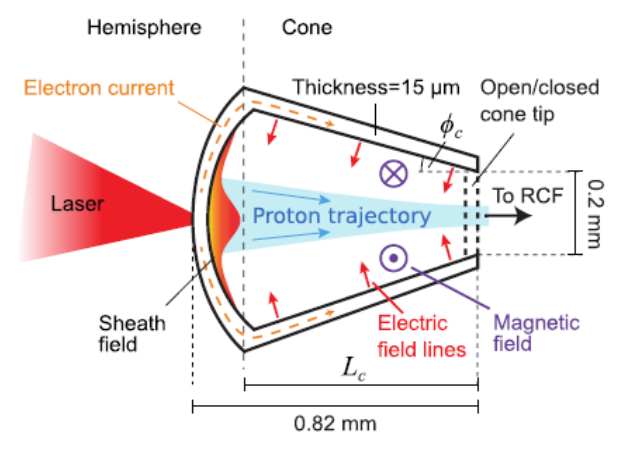A team of researchers led by Paul McKenna, from the Cockcroft Institute / University of Strathclyde, has published an article investigating the focusing of laser-accelerated protons using hemisphere-cone targets.
Relativistically intense laser light interacting with solid density targets can accelerate protons to multi-MeV energies. The most studied and robust mechanism of laser-driven ion acceleration is the target normal sheath acceleration (TNSA).
The intrinsic properties of these beams of protons, such as their short bunch duration and high flux, make them potentially useful as a driver of the fast ignition approach to inertial confinement fusion (often referred to as proton fast ignition or PFI).
For PFI, control of the spatial profile of the proton beam, and thus the energy deposition profile within the plasma, along with sufficient laser energy conversion into higher energy protons is required to provide the necessary flux to achieve ignition.
Whereas typically TNSA studies involve thin planar foils from which a diverging proton beam is produced, it has previously been shown that some degree of proton beam focusing can be achieved by using a curved, hollow hemispherical target such that the protons leave the source region directed towards a central axis. The degree of focusing achieved by this approach is, however, limited by Coulomb repulsion within the beam, which increases with charge density.
Recently, focusing has also been reported using a closed conical target. For a PFI scenario, a conical structure has the additional advantage of protecting the proton source region from the compressed plasma fuel, in particular when using a closed geometry.

The latest work by Paul McKenna and collaborators explored experimentally and numerically the influence of the cone section of a hemisphere-cone target on proton beam focusing. The investigation also included the effects of having the cone tip open and closed. The experiment was performed using the Orion laser with intensities around 1020 Wcm−2.
The open cone configuration is found to result in proton focusing in the energy range of 9 to 24 MeV, and produce an annular profile for higher energy components, up to 55 MeV, while the spatial distribution of lower energy components remains unchanged. By contrast, for the closed cone case, the focusing effect is diminished by the fields present on the inner wall of the cone tip.
Simulations reveal that strong electrostatic and magnetic fields present on the inner surfaces of the target induce the focusing effect with the open cone, but also result in proton divergence in the case of the closed cone. Additionally, the simulations demonstrate the possibility to tailor the cone geometry to select the energy range over which the focusing occurs.
This approach could prove useful for focusing and increasing proton flux at selected energies for applications such as isochoric heating of materials and PFI.
This research has been published in Plasma Physics and Controlled Fusion:
‘Geometry effects on energy selective focusing of laser-driven protons with open and closed hemisphere-cone targets’ M King et al 2024 Plasma Phys. Control. Fusion 66 01500.
